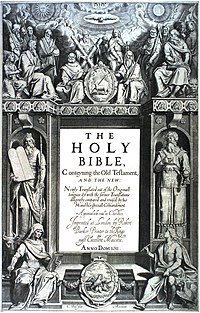

Alexandrian text-type (image courtesy Wikipedia) King James (Authorised) Version, (image courtesy Wikipedia)
By Spencer D Gear
A fellow wrote on an Internet forum, ‘If your bible is not translated from the Textus Receptus, then you have only and imitation bible, not authentic’.[1] This was the response:
I’m not sure you know what the TR [Textus Receptus] even is.
The term “Textus Receptus” is mostly an anachronism. A term applied to a textual lineage that influenced the translations of the Reformation and post-Reformation period during the 16th and 17th centuries.
But there did not exist a “Textus Receptus” as a singular, uniform textual edition until later. Rather, the TR is a composite of numerous critical editions of the Greek New Testament that includes several editions from Erasmus alone, in addition to critical editions produced by Stephanus and Beza. None of these critical editions agreed entirely with one another, and even throughout Erasmus’ scholarly career his critical edition went through numerous edits and changes.
The Authorized Version of King James I of England was a translation from these many Greek texts, with the various scholars working and choosing which variants were preferable and in some cases lifting entire portions piecemeal from previous English translations such as Tyndale’s Version. Beyond these, the translators relied upon traditional readings taken from the Vulgate (such can be seen in the KJV translation of Isaiah 14:12 which retains the Vulgate’s “lucifer”). Even after the 1611 edition, it went through numerous re-edits until the situation with the Authorized Version had become a total mess, and a standardized text was put forth in 1769, which is the “King James Version” we all know today.
Why should we limit translations to an arbitrary set of competing and conflicting–and outdated–critical editions of the Greek text (i.e. the Textus Receptus) when we have a far larger library of textual manuscripts available, far superior critical editions at our disposal, and nearly five hundred years of adept scholarship at our collective fingertips in order to present far superior translations of Holy Scripture for our benefit and edification?[2]
Bruce Metzger’s assessment of Greek New Testaments

(image courtesy Wikipedia)
[3]I recommend one of the outstanding textual critics of the 20th century, the late Dr. Bruce Metzger. In The Text of the New Testament: Its Transmission, Corruption and Restoration (Metzger 1992), you will learn:
1. ‘In 1514 the first printed Greek New Testament came from the press, as part of the Polyglot Bible’ (1992:96);
2. ‘Though the Complutensian text was the first Greek New Testament to be printed, the first Greek New Testament to be published (that is, put on the market) was the edition prepared by the famous Dutch scholar and humanist Desiderius Erasmus of Rotterdam (1469-1536). It cannot be determined exactly when Erasmus first decided to prepare an edition of the Greek Testament, but on a visit to Basle in August 1514 he discussed (probably not for the first time) the possibility of such a volume with the well-known publisher Johann Froben…. The printing began on 2 October 1515, and in a remarkably short time (1 March 1516) the entire edition was finished, a large folio volume of about 1,000 pages which, as Erasmus himself declared later, was “precipitated rather than edited” (praecipitatum verius quam editum). Owing to the haste in production, the volume contains hundreds of typographical errors; in fact, Scrivener once declared, “[It] is in that respect the most faulty book I know.’ (1992:98, 99).
3. ‘Here and there in Erasmus’ self-made Greek text are readings which have never been found in any known Greek manuscript–but which are still perpetuated today in printings of the so-called Textus Receptus of the Greek New Testament. Even in parts of the New Testament Erasmus occasionally introduced into his Greek text material taken from the Latin Vulgate. Thus in Acts ix. 6…. This … became part of the Textus Receptus, from which the King James version was made in 1611′ (1992:100).
4. ‘The second edition [of Erasmus’ Greek text] became the basis of Luther’s German translation…. It has often been debated how far Luther’s translation rests on the Greek text’ (1991:100; 100 n. 2).
5. ‘Subsequently Erasmus issued a fourth and definitive edition (1527), which contains the text of the New Testament in three parallel columns, the Greek, the Latin Vulgate, and Erasmus’ own Latin version’ (1992:102).
6. ‘Thus the text of Erasmus’ Greek New Testament rests upon a half dozen minuscule [i.e. running writing] manuscripts’ (1992:102).
7. ‘Subsequent editors, though making a number of alterations in Erasmus’ text, essentially reproduced this debased form of the Greek Testament. Having secured an undeserved pre-eminence, what came to be called the Textus Receptus of the New Testament resisted for 400 years all scholarly efforts to displace it in favour of an earlier and more accurate text’ (1992:103).
8. “The first edition of the whole Bible in Greek was published in three parts in February 1518 at Venice by the celebrated Aldine press. The New Testament, which is dedicated to Erasmus, follows the first edition of Erasmus so closely as to reproduce many typographical errors–even those which Erasmus had corrected in the list of errata’ (1992:103).
9. ‘Theodore de Beze (Beza, 1519-1605), a friend and successor of Calvin at Geneva and an eminent classical and Biblical scholar, published no fewer than nine editions of the Greek Testament between 1565 and 1604, and a tenth edition appeared posthumously in 1611….The importance of Beza’s work lies in the extent to which his editions tended to popularize and to stereotype the Textus Receptus. The King James translators of 1611 made large use of Beza’s editions of 1588-9 and 1698’ (1992:105).
10. ‘The next stage in the history of New Testament textual criticism is characterized by assiduous efforts to assemble variant readings from Greek manuscripts, versions, and Fathers. For almost two centuries scholars ransacked libraries and museums, in Europe as well as the Near East, for witnesses to the text of the New Testament. But almost all of the editors of the New Testament during this period were content to reprint the time-honoured but corrupt Textus Receptus, relegating the evidence for the earlier readings to the apparatus. An occasional brave soul who ventured to print a different form of Greek text was either condemned or ignored’ (1992:106).
Is the New Living Translation a paraphrase or dynamic equivalence?
A fellow on the Forum wrote: ‘the NLT is a paraphrase’.[4] I had stated that the NIV and NLT used dynamic equivalence. To check out which philosophy of translation the NLT uses, I looked up my hard copy of the NLT and the NLT website. This is what I found:

(image courtesy NLT)
INTRODUCTION TO THE NEW LIVING TRANSLATION
Translation Philosophy and Methodology
English Bible translations tend to be governed by one of two general translation theories. The first theory has been called “formal-equivalence,” “literal,” or “word-for-word” translation. According to this theory, the translator attempts to render each word of the original language into English and seeks to preserve the original syntax and sentence structure as much as possible in translation. The second theory has been called “dynamic-equivalence,” “functional-equivalence,” or “thought-for-thought” translation. The goal of this translation theory is to produce in English the closest natural equivalent of the message expressed by the original-language text, both in meaning and in style.
Both of these translation theories have their strengths. A formal-equivalence translation preserves aspects of the original text—including ancient idioms, term consistency, and original-language syntax—that are valuable for scholars and professional study. It allows a reader to trace formal elements of the original-language text through the English translation. A dynamic-equivalence translation, on the other hand, focuses on translating the message of the original-language text. It ensures that the meaning of the text is readily apparent to the contemporary reader. This allows the message to come through with immediacy, without requiring the reader to struggle with foreign idioms and awkward syntax. It also facilitates serious study of the text’s message and clarity in both devotional and public reading.
The pure application of either of these translation philosophies would create translations at opposite ends of the translation spectrum. But in reality, all translations contain a mixture of these two philosophies. A purely formal-equivalence translation would be unintelligible in English, and a purely dynamic-equivalence translation would risk being unfaithful to the original. That is why translations shaped by dynamic-equivalence theory are usually quite literal when the original text is relatively clear, and the translations shaped by formal-equivalence theory are sometimes quite dynamic when the original text is obscure.
The translators of the New Living Translation set out to render the message of the original texts of Scripture into clear, contemporary English. As they did so, they kept the concerns of both formal-equivalence and dynamic-equivalence in mind. On the one hand, they translated as simply and literally as possible when that approach yielded an accurate, clear, and natural English text. Many words and phrases were rendered literally and consistently into English, preserving essential literary and rhetorical devices, ancient metaphors, and word choices that give structure to the text and provide echoes of meaning from one passage to the next.
On the other hand, the translators rendered the message more dynamically when the literal rendering was hard to understand, was misleading, or yielded archaic or foreign wording. They clarified difficult metaphors and terms to aid in the reader’s understanding. The translators first struggled with the meaning of the words and phrases in the ancient context; then they rendered the message into clear, natural English. Their goal was to be both faithful to the ancient texts and eminently readable. The result is a translation that is both exegetically accurate and idiomatically powerful.[5]
What is dynamic equivalence?
Wycliffe Bible Translators (and SIL) are experts in translating the Bible into languages for which there has been no Bible in print. These are their definitions of ‘formal equivalence’ and ‘dynamic equivalence’ for translations.
It was linguist, Dr. Eugene Nida, who introduced the concept of dynamic equivalence. Wycliffe Bible Translators website explains:
Throughout his travels as a consultant, Dr. Nida urged translators to learn the culture as well as the language of the people they served. He was also concerned that they understand the culture of the Bible so they could translate the meaning of the text from one culture to another, rather than attempt a literal word-for-word translation. This led him to write several landmark books on what is now termed “functional equivalence” or “dynamic equivalence.” While there is debate about “literal” versus “functional equivalence” translation methods, there is little doubt that Nida’s influence has allowed millions of people around the world to read the Word of God in a language that speaks to their hearts.[6]
Nida explained the meaning of ‘dynamic equivalence’:
In such a translation one is not so concerned with matching the receptor-language message with the source-language message, but with the dynamic relationship…, that the relationship between receptor and message should be substantially the same as that which existed between the original receptors and the message.
A translation of dynamic equivalence aims at complete naturalness of expression, and tries to relate the receptor to modes of behavior relevant within the context of his own culture; it does not insist that he understand the cultural patterns of the source-language context in order to comprehend the message. (Nida 1964:159)
Stated as a kind of formula, we may say that for the type of message contained in the New Testament, we are concerned with a relationship such as can be expressed in the following equation:

That is to say, the receptor in the circle culture should be able, within his own culture, to respond to the message as given in his language, in substantially the same manner as the receptor in the triangle culture responded, within the context of his own culture, to the message as communicated to him in his own language. (Nida 1964:148-149)[7]
For an exposé on dynamic equivalence, see the article by Robert L. Thomas, ‘Dynamic equivalence: A method of translation or a system of hermeneutics’. See also D A Carson, ‘The limits of dynamic equivalence in Bible translation’.
Conclusion
The Erasmus Greek text that became the Textus Receptus and had so much influence on the text used for the translation of the KJV New Testament, but it is based on a ‘debased form of the Greek Testament’ (Metzger’s words).
Better Greek manuscripts are available in the twenty-first century and most of the new translations are based on these texts. The Greek text gathered by Erasmus that became the Textus Receptus is not the most reliable Greek text available for NT translation. The manuscripts found since the time of Erasmus and the eclectic Greek text of Nestle-Aland 26, which is used in the United Bible Societies Greek NT (edition 27 is now available), provide a more reliable Greek text from which to translate. The latter Greek text is used in such English Bible translations as the RSV, NRSV, ESV, NET, NIV, NASB and NLT.
However, there is no point in trying to convince a dogmatic KJV-only supporter of these details.
Works consulted
Metzger, B 1992. The text of the New Testament: Its transmission, corruption and restoration. New York / Oxford: Oxford University Press.
Nida, E A 1964. Toward a science of translating. Leiden: E J Brill.
Notes:
[1] Christian 12#93, Christian Forums, Christian Scriptures, ‘King James Version why the best?’, available at: http://www.christianforums.com/t7656653-9/ (Accessed 21 July 2012).
[2] Ibid, CryptoLutheran#106.
[3] I posted this in ibid., OzSpen#127.
[4] Ibid., Michaelrh1325#126. Part of my response to him was that he needed to know what he was talking about.
[5] New Living Translation website, available at: http://www.newlivingtranslation.com/05discoverthenlt/nltintro.asp (Accessed 21 July 2012).
[6] ‘Eugene Nida’, Wycliffe, available at: http://www.wycliffe.org/Go/careers/typesofwork/languagework/translation.aspx?CaseStudyId=94&ModuleID=831&printerfriendly=yes (Accessed 21 July 2012).
[7] Glenn J. Kerr 2011. Dynamic equivalence and its daughters: Placing Bible translation theories in their historical context. Journal of Translation 7(1). SIL. Available at: http://www.sil.org/system/files/reapdata/77/94/02/77940241319795795123525485356849279212/siljot2011_1_01.pdf (Accessed 1 June 2016).
Copyright © 2012 Spencer D. Gear. This document last updated at Date: 16 June 201, .








![]()
![]()
![]()
![]()
![]()
![]()
![]()















![clip_image003[4] clip_image003[4]](https://i0.wp.com/spencer.gear.dyndns.org/wp-content/uploads/2012/07/clip_image0034_thumb.jpg?resize=154%2C231)